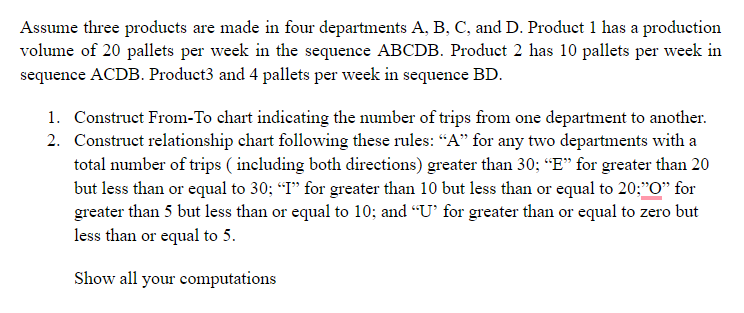Assume three products are made in four departments A, B, C, and D. Product 1 has a productic volume of 20 pallets per week in the sequence ABCDB. Product 2 has 10 pallets per week sequence ACDB. Product3 and 4 pallets per week in sequence BD. 1. Construct From-To chart indicating the number of trips from one department to another. 2. Construct relationship chart following these rules: "A" for any two departments with a total number of trips ( including both directions) greater than 30; “E" for greater than 20 but less than or equal to 30; “I" for greater than 10 but less than or equal to 20;"O" for greater than 5 but less than or equal to 10; and “U' for greater than or equal to zero but less than or equal to 5.
Assume three products are made in four departments A, B, C, and D. Product 1 has a productic volume of 20 pallets per week in the sequence ABCDB. Product 2 has 10 pallets per week sequence ACDB. Product3 and 4 pallets per week in sequence BD. 1. Construct From-To chart indicating the number of trips from one department to another. 2. Construct relationship chart following these rules: "A" for any two departments with a total number of trips ( including both directions) greater than 30; “E" for greater than 20 but less than or equal to 30; “I" for greater than 10 but less than or equal to 20;"O" for greater than 5 but less than or equal to 10; and “U' for greater than or equal to zero but less than or equal to 5.
Elements Of Electromagnetics
7th Edition
ISBN:9780190698614
Author:Sadiku, Matthew N. O.
Publisher:Sadiku, Matthew N. O.
ChapterMA: Math Assessment
Section: Chapter Questions
Problem 1.1MA
Related questions
Question

Transcribed Image Text:Assume three products are made in four departments A, B, C, and D. Product 1 has a production
volume of 20 pallets per week in the sequence ABCDB. Product 2 has 10 pallets per week in
sequence ACDB. Product3 and 4 pallets per week in sequence BD.
1. Construct From-To chart indicating the number of trips from one department to another.
2. Construct relationship chart following these rules: “A" for any two departments with a
total number of trips ( including both directions) greater than 30; “E" for greater than 20
but less than or equal to 30; “I" for greater than 10 but less than or equal to 20;"O" for
greater than 5 but less than or equal to 10; and “U' for greater than or equal to zero but
less than or equal to 5.
Show all your computations
Expert Solution
This question has been solved!
Explore an expertly crafted, step-by-step solution for a thorough understanding of key concepts.
This is a popular solution!
Trending now
This is a popular solution!
Step by step
Solved in 2 steps with 2 images

Recommended textbooks for you

Elements Of Electromagnetics
Mechanical Engineering
ISBN:
9780190698614
Author:
Sadiku, Matthew N. O.
Publisher:
Oxford University Press

Mechanics of Materials (10th Edition)
Mechanical Engineering
ISBN:
9780134319650
Author:
Russell C. Hibbeler
Publisher:
PEARSON

Thermodynamics: An Engineering Approach
Mechanical Engineering
ISBN:
9781259822674
Author:
Yunus A. Cengel Dr., Michael A. Boles
Publisher:
McGraw-Hill Education

Elements Of Electromagnetics
Mechanical Engineering
ISBN:
9780190698614
Author:
Sadiku, Matthew N. O.
Publisher:
Oxford University Press

Mechanics of Materials (10th Edition)
Mechanical Engineering
ISBN:
9780134319650
Author:
Russell C. Hibbeler
Publisher:
PEARSON

Thermodynamics: An Engineering Approach
Mechanical Engineering
ISBN:
9781259822674
Author:
Yunus A. Cengel Dr., Michael A. Boles
Publisher:
McGraw-Hill Education

Control Systems Engineering
Mechanical Engineering
ISBN:
9781118170519
Author:
Norman S. Nise
Publisher:
WILEY

Mechanics of Materials (MindTap Course List)
Mechanical Engineering
ISBN:
9781337093347
Author:
Barry J. Goodno, James M. Gere
Publisher:
Cengage Learning

Engineering Mechanics: Statics
Mechanical Engineering
ISBN:
9781118807330
Author:
James L. Meriam, L. G. Kraige, J. N. Bolton
Publisher:
WILEY